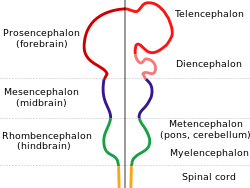Forebrain
| Forebrain (Prosencephalon) | |
|---|---|
 | |
| Identifiers | |
| MeSH | D016548 |
| NeuroNames | 27 |
| NeuroLexID | birnlex_1509 |
| TA98 | A14.1.03.006 |
| TA2 | 5416 |
| TE | E5.14.1.0.2.0.10 |
| FMA | 61992 |
| Anatomical terms of neuroanatomy | |
In theanatomyof thebrainofvertebrates,theforebrainorprosencephalonis therostral(forward-most) portion of thebrain.The forebrain controls body temperature, reproductive functions, eating, sleeping, and the display of emotions.
Vesicles of the forebrain (prosencephalon), themidbrain(mesencephalon), andhindbrain(rhombencephalon) are the threeprimary brain vesiclesduring the earlydevelopment of the nervous system.At the five-vesicle stage, the forebrain separates into thediencephalon(thalamus,hypothalamus,subthalamus,andepithalamus) and thetelencephalonwhich develops into thecerebrum.The cerebrum consists of thecerebral cortex,underlyingwhite matter,and thebasal ganglia.
In humans, by 5 weeks in utero it is visible as a single portion toward the front of the fetus. At 8 weeks in utero, the forebrain splits into the left and right cerebral hemispheres.
When the embryonic forebrain fails to divide the brain into two lobes, it results in a condition known asholoprosencephaly.The parts present in the forebain are cerebrum, thalamus and hypothalamus.
See also[edit]
References[edit]
- NIF Search - ForebrainArchived2016-03-04 at theWayback Machinevia theNeuroscience Information Framework
